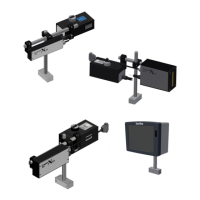Appendix H Using the BCD label selection
Introduction
Using BCD codes to select a label for printing has been around for quite a
while and according to the questions we as Kortho have received from
distributors, it is still actively used e.g. in the tile and wood industry.
BCD stands for Binary Coded Decimal. This is a method that uses the binary
digits 0, which represents OFF and 1, which represents ON. Each digit of the
number is encoded by a group of four bits which are a binary representation of
the decimal number in question. Every digit is called a bit. Four bits are called
a nibble. A Nibble is used to represent each decimal digit (0 to 9). The TsC20
can receive a two decimal digit (1 - 99) so max two nibbles.
When converting a decimal number to a BCD code, one has to convert an
individual digit in a 4-bit format. See the picture. Black boxes are bits that are
ON (1), white boxes are bits that are OFF (0). If for example the digit 7 will be
transferred to BCD code this will be 8=off, 4=on, 2=on, 1=on, so this will be produced as 0111 (“0+4+2+1”). For
a two decimal digit, i.e. 93, this will be 1001 0011 ( “8+0+0+1” + “0+0+2+1”).
The host, a system that outputs products that vary in composition constantly, generates a BCD code to
indicate what product has been output. This BCD code can be used by the TSC20 to select a label that needs
to be printed onto this product.
Usually, the variation in products is limited to 10 or 20 variants. So, the TsC20 needs to have all the labels
present on the system in order to print the correct label onto the correct product.
Generally, the printer is located further away on the production line because it simply cannot be installed
directly at the location where the product leaves the host. In most cases, this means that there are a number
of different products between host and printer.
This requires for the system to track which product needs to be printed with the required label. To solve this,
a FIFO (First In First Out) print list is also implemented in the TsC20 to be able to store the BCD codes
generated by the host. This print list has a limit of 50 BCD codes.
Prerequisites.
In order to be able to use the BCD label selection feature, one requires the TsC20 DUO controller (art. nr.
818131). This controller has the BCD hardware fitted on the CPU board. The BCD input is a 15-way SUB-D
connector, X07, located on the connector plate at the bottom of the controller.
Also, the hardware for the product detect input is fitted on the CPU board which allows one to detect the
product at the moment the host has created a valid BCD code. This product detect input is available through
connector X08 on the connector plate.
Selecting a label through BCD is available since version 1.0-16032016a.
Label name requirements for BCD selection
In order for labels to be selected by a BCD code, the names of the labels need to
conform to the following naming convention. The user is required to give the labels
a name that corresponds with the BCD code that is generated by the host in order to
print the correct label on the product.
This is done by giving the labels the following names: BCD_XX_Y.ZZZ

